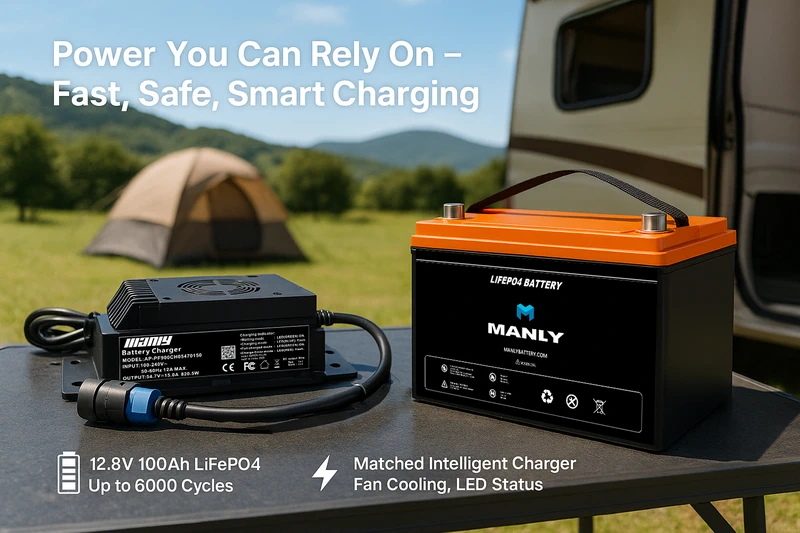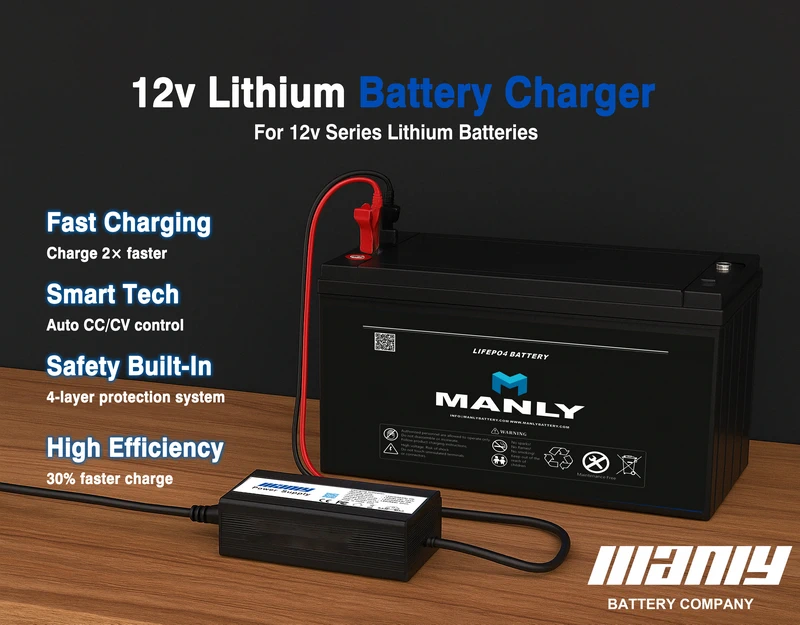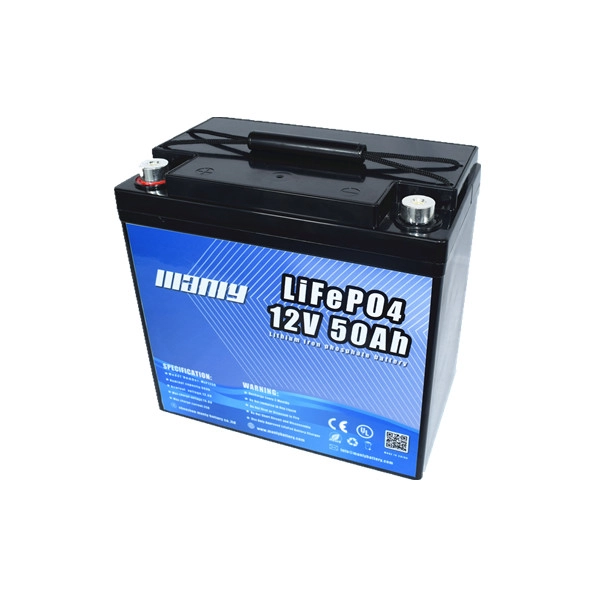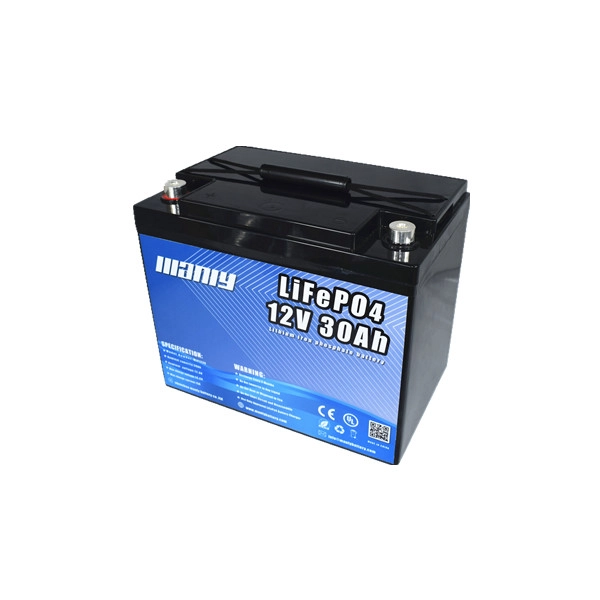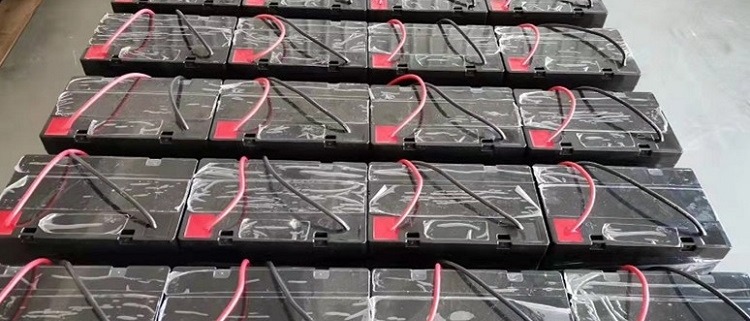How Long To Charge a 12v Battery At 10 Amps
Table of Contents
- How Long To Charge a 12v Battery At 10 Amps
- Factors Affecting Charging Time
- Calculation of Charging Time
- The Steps To Charge a 12V Battery
- Practical Considerations
- Can You Speed Up Charging?
- Troubleshooting Common Battery Charging Issues
- Safety and Maintenance
- Conclusion
- FAQ
- Learn More About Battery
- Introduction of Solar Light: Battery Innovations
- Guide to Choosing the Best Solar Street Lights
- Do Solar Lights Need Batteries
- A Guide to Solar Lights Batteries and Their Advantages
- MANLY 12V Lithium Batteries: Powering Solar Lights with Excellence
- Switzerland customer 430pcs 12.8V 80Ah lithium UPS battery ,ready for shipment.
- Italy customer 2000pcs 6V 4.5Ah lithium battery for toy car , ready for shipment.
Charging a 12V battery with a 10 amp battery charger might sound simple, but many factors can affect how long it actually takes. From battery size and health to temperature and charger efficiency, each detail plays a role in determining your total charge time. Whether you’re using a smart model from a china battery charger factory or a basic unit from your local store, understanding these variables can help you charge faster, safer, and smarter. This guide breaks down the math, best practices, and common issues so you can get the most out of your battery chargers every time.
Factors Affecting Charging Time
1. Battery Capacity (Ah)
Battery capacity, measured in amp-hours (Ah), represents how much electric charge a battery can hold. Simply put, the larger the capacity, the longer it takes to charge. For example, if you’re using a 10 amp battery charger to charge a 100Ah battery, it would take roughly 10 hours to reach a full charge. The basic formula is:
Charging Time (hours) = Battery Capacity (Ah) ÷ Charging Current (A)
So, if you’re charging a 20Ah battery at 10 amps, expect it to take about 2 hours. A 50Ah battery would need approximately 5 hours under the same conditions. This relationship remains consistent across various battery sizes, assuming the charger maintains a steady current throughout the process.
2. Charging Current (Amps)
The charging current is the amount of electrical current delivered to the battery, measured in amps. Higher currents can reduce charging time, but they also raise the risk of excess heat, which can damage internal components over time. That’s why using a charger with the right current output—like a 10 amp battery charger for mid-sized batteries—is essential. This balances faster charging with the safety and longevity of the battery. Always follow the recommendations provided by the battery charger manufacturer or the battery’s technical datasheet to prevent overheating or short cycling.
3. Efficiency of the Charging Process
Not all the energy you feed into a battery gets stored—some is lost, usually as heat. Charging efficiency refers to the proportion of input energy that the battery can actually retain. For example, if a battery’s charging efficiency is 90%, then 10% of the energy is lost in the process. This means the actual time to charge may be longer than the theoretical value. Lithium-ion batteries, especially those produced by top china smart battery charger suppliers, generally boast higher efficiency levels (up to 95%) compared to traditional lead-acid types, which can drop below 85%. The type of charger also matters—china 12v lithium battery charger models are often optimized for better efficiency and heat management.
4. Importance of Battery Health
Battery health is a major factor in determining how long charging will take. As batteries age or experience repeated deep discharges, their internal resistance increases, slowing down the charging process. Environmental conditions—like extreme heat or freezing cold—can also reduce a battery’s ability to accept and hold a charge. A degraded battery might never fully charge or may take significantly longer than expected. To maintain performance, avoid exposing the battery to harsh temperatures and refrain from letting it discharge completely. Consistent maintenance not only helps preserve capacity but also ensures reliable operation with battery chargers of all types, including those from a china battery charger factory.
Calculation of Charging Time
Example Calculation
To determine how long it takes to fully charge a battery, you can start with a basic formula:
Charging Time (hours) = Battery Capacity (Ah) ÷ Charging Current (A)
Let’s break it down with a practical example. Suppose you’re charging a 100Ah battery using a 10 amp battery charger. The estimated charging time would be:
100Ah ÷ 10A = 10 hours
This calculation assumes perfect charging conditions—specifically, 100% efficiency. But in real-world applications, charging isn’t that flawless. Energy is lost in the form of heat, and actual charging efficiency usually ranges between 80% and 95%, depending on the battery chemistry and the quality of the charger.
To get a more accurate estimate, you should factor in charging efficiency. The revised formula looks like this:
Charging Time = Battery Capacity (Ah) ÷ (Charging Current (A) × Charging Efficiency)
Let’s say the efficiency is 85% (or 0.85 as a decimal). Using the same 100Ah battery and 10 amp battery charger, the calculation becomes:
Charging Time = 100Ah ÷ (10A × 0.85) ≈ 11.76 hours
So, instead of 10 hours, it would actually take nearly 11.8 hours to fully charge the battery under normal efficiency conditions. This adjustment reflects the typical loss that occurs during the conversion of AC power to stored DC energy inside the battery.
These formulas are especially helpful when selecting chargers from a battery charger manufacturer or comparing models from a china battery charger factory. Whether you’re choosing a basic china battery charger or a high-performance china smart battery charger, knowing how efficiency impacts charging time helps ensure you don’t undercharge or overwork your battery.
The Steps To Charge a 12V Battery
Charging a 12V battery correctly isn’t just about plugging in a charger—it’s a step-by-step process that helps you get the most out of your battery while keeping things safe. Whether you’re using basic battery chargers or a high-efficiency china smart battery charger, following the right steps ensures consistent performance and extends battery life.
1. Preparation
Ensure Proper Ventilation
Start by choosing a well-ventilated area. Charging a lead-acid or flooded 12V battery can release hydrogen gas, which is highly flammable. To reduce risk, make sure the area is free of open flames, sparks, or smoking.
Check Compatibility
Before connecting anything, confirm that your charger matches your battery’s voltage and chemistry. For example, a 12v battery manufacturer might require a charger tailored for lithium, AGM, or lead-acid cells. Using an incompatible charger may reduce battery performance or cause permanent damage.
Inspect All Equipment
Look over both the battery and the charger. If you see corrosion on the terminals or cracks in the casing, clean or replace the parts before proceeding. Chargers from reliable sources like a china battery charger factory are designed to reduce risk, but visual inspection is always the first line of safety.
2. Connecting the Charger
Attach the Positive Clamp
Take the red clamp from the charger and securely connect it to the battery’s positive terminal, marked with a “+” sign.
Attach the Negative Clamp
Then, connect the black clamp to the negative terminal, marked with a “–” sign. Always follow this sequence to minimize sparks and protect your gear.
3. Setting Charging Parameters
Adjust to the Right Settings
Set the charger to deliver the correct current. For medium-capacity batteries, a 10 amp battery charger offers a safe and efficient balance between charge time and heat generation.
Select the Proper Charging Mode
Modern china 12v lithium battery charger models often include selectable modes—standard, AGM, lithium, etc. Choose the one that aligns with your battery’s type to prevent overcharging or undercharging.
4. Initiating the Charging Process
Turn on the Charger
Once everything is securely connected and properly set, switch on the charger. If you’re using a smart charger from a trusted battery charger manufacturer, the device will likely auto-regulate voltage and current.
Monitor Charging Progress
Watch the status indicators or digital display if your charger includes one. Many china battery charger models provide real-time voltage or charge percentage, helping you track the process without guesswork.
5. Completing the Charge
Turn Off the Charger First
Before disconnecting anything, power down the charger completely. This step prevents electrical arcing and ensures a safe shutdown.
Disconnect Clamps in Reverse Order
Remove the black (negative) clamp first, then the red (positive) clamp. Reversing the connection sequence reduces the risk of a short circuit.
6. Post-Charging Checks
Verify the Voltage
Use a multimeter to confirm the battery is fully charged. A typical reading should be around 12.6 to 12.8 volts for most 12V lead-acid batteries at rest.
Tidy the Area
Once done, clean up the workspace. Remove tools, wipe down the charger, and store cables properly to keep your setup ready for the next use.
Practical Considerations
Impact of Temperature on Charging Time
Temperature plays a major role in how efficiently and safely a battery charges. Charging performance changes significantly depending on how hot or cold the environment is.
Cold Temperatures Slow Charging
When batteries are exposed to low temperatures—especially below 32°F (0°C)—their internal resistance increases. This makes it harder for ions to move within the cells, slowing down the charging process. For lithium-ion batteries in particular, cold conditions can cause lithium plating, which permanently reduces capacity and raises safety concerns. Studies from Battery University and others confirm that charging lithium-ion cells below freezing should be avoided whenever possible.
Heat Speeds Up Reactions—But Increases Risk
At higher temperatures, electrochemical reactions inside the battery accelerate. This may seem like an advantage for faster charging, but it comes at a cost. Excessive heat raises the chance of thermal runaway—a chain reaction where heat builds up uncontrollably, potentially causing the battery to swell, leak, or even ignite. Using china smart battery charger models with built-in temperature sensors can help manage these risks.
Best Practice: Charge at Room Temperature
For safety and efficiency, it’s best to charge batteries at moderate room temperature—around 77°F (25°C). This range supports stable electrochemical performance while minimizing stress on the battery materials.
Can You Speed Up Charging?
Yes—charging a battery faster is possible, but it comes with trade-offs. You can reduce charging time by increasing current, using fast-charging technology, and managing environmental conditions. However, rushing the process too often can shorten battery life. The key is to find the right balance between speed and longevity.
1. Use a Higher-Current Charger
The easiest way to speed up charging is to increase the current. For example, a 10 amp battery charger can fill a 100Ah battery in roughly 10 hours. By contrast, a 5 amp charger would double that time. The math is simple, but the safety isn’t—charging too fast with an incompatible charger can lead to overheating or battery damage.
Always check the battery’s rated maximum charge current, which is typically listed in the datasheet from your 12v battery manufacturer. Overloading the cells can reduce capacity over time or cause failure. Choosing a charger that matches your battery type and size—such as one from a trusted china battery charger factory—helps protect both speed and safety.
2. Utilize Fast-Charging Technologies
Fast-charging protocols like USB Power Delivery (PD) and Qualcomm Quick Charge (QC) are designed to increase power delivery without sacrificing safety. These systems dynamically adjust voltage and current based on real-time feedback between the charger and the device. For instance, Quick Charge 4.0 can push up to 27 watts, cutting down charge time significantly compared to traditional 5W outputs.
That said, the charger and the device must both support the same fast-charging standard. Using a china smart battery charger or a china 12v lithium battery charger that matches your battery’s chemistry—like LiFePO4 or NMC—is essential. Many advanced battery chargers also include protections for overvoltage, overcurrent, and thermal regulation to ensure charging stays efficient and safe.
3. Optimize Charging Environment
The temperature around your battery has a direct impact on how fast and efficiently it charges. Charging at room temperature—about 77°F (25°C)—allows batteries to perform optimally. When it’s too cold, internal resistance increases, slowing down the charging reaction. When it’s too hot, chemical activity speeds up—but so does battery degradation.
To get the most from your battery chargers, place them in a well-ventilated, shaded space away from heaters, direct sunlight, or cold drafts. Maintaining this temperature range helps chargers—especially high-performance units from a battery charger manufacturer—deliver consistent results without stressing the battery.
4. Consider Battery Health
While fast charging can be convenient, repeated exposure to high currents can cause additional heat buildup inside the cells. This can accelerate wear and reduce the total number of charge cycles a battery can handle. For long-term use, it’s wise to alternate fast charging with slower, controlled cycles.
Many smart chargers today include a battery health mode that limits current after a certain voltage threshold. If you regularly rely on fast charging, look for this feature in models from leading china battery charger suppliers to help extend battery life while still saving time when it counts.
Troubleshooting Common Battery Charging Issues
If your battery isn’t charging as expected, don’t panic. Many charging problems can be traced to common causes—and most can be fixed quickly once you know what to look for. Below, we walk through frequent charging issues and offer practical solutions to keep your battery chargers and batteries performing reliably.
1. Battery Not Charging
Potential Causes and Fixes:
Damaged Charger or Cable
Inspect the power cord and charging unit for signs of fraying, bent prongs, or overheating. Swap in another charger—ideally from a trusted battery charger manufacturer—to rule out hardware failure.Wrong Charger Type
Using the wrong charger can completely prevent charging. For example, a lithium battery requires a dedicated lithium battery charger—not just any generic model. Always verify that your charger matches your battery’s voltage and chemistry.Incorrect Terminal Connections
Check that the red (positive) and black (negative) leads are connected properly. Reversed clamps or loose terminals can disrupt the charging process or cause damage.Battery Management System (BMS) Lockout
Some batteries, especially lithium types, use a BMS that can temporarily shut off charging to protect the cells. If the system won’t reset, contact the 12v battery manufacturer or use a smart diagnostic charger designed for BMS-equipped batteries.
2. Slow Charging
Common Explanations:
Low Charging Current
If your charger supplies insufficient current, expect long charging times. Upgrading to a 10 amp battery charger, when suitable for your battery size, can significantly reduce charge duration.Battery Wear or Age
Older batteries or those that have been deeply discharged multiple times will typically charge more slowly. Run a capacity test if charging seems unusually sluggish.Temperature-Related Slowdown
Both hot and cold temperatures affect charging efficiency. Aim to charge batteries indoors at room temperature (around 77°F or 25°C) for optimal performance. Smart models from a china smart battery charger supplier can help regulate temperature automatically.
3. Charger Overheating
What to Watch For:
Prolonged High Output
Continuous operation at maximum output can cause a charger to overheat. If you’re running your charger for hours without breaks—especially near or above its rated capacity—consider taking cooling intervals or upgrading to a higher-rated unit from a china battery charger factory.Poor Airflow Around the Charger
Keep the charger in a well-ventilated, open space. Avoid covering it with objects or placing it near other heat sources.Exceeding Load Limits
Never exceed the amperage or voltage limits of your charger. Doing so may overwork the internal components and shorten the charger’s service life.
4. Battery Overheating
Primary Causes and Solutions:
Excessive Charging Current
Using a charger that exceeds your battery’s rated input current can cause internal cell temperatures to spike. Stick to the specs listed by your battery manufacturer and avoid using low-quality generic models.Hot Charging Environment
If you’re charging outdoors or in a garage during hot summer months, the ambient heat can compound internal temperature rise. Move your setup to a cooler, shaded, or climate-controlled location.Battery Degradation
Batteries naturally degrade over time. If a unit frequently overheats during charging—even under normal conditions—it may be time to replace it. Look for bulging, discoloration, or voltage drop under load as warning signs.
Safety and Maintenance
Maintaining your battery the right way isn’t just about performance—it’s also about safety. Consistent care and proper charging practices can extend battery life, reduce risks, and ensure your battery chargers operate efficiently without fail.
1. Avoiding Overcharging
Overcharging is one of the most common causes of battery damage. It leads to heat buildup, cell swelling, and a shortened lifespan.
Use Smart Chargers with Auto Shutoff
Smart charging devices—such as a MANLY 12v lithium battery charger—can automatically detect when your battery is full and stop charging to prevent overcharging. This feature protects the battery from stress and reduces the risk of overheating or fire.Set Charging Timers for Manual Chargers
If you’re using a charger without auto shutoff, calculate charging time using this formula:
Charging Time = Battery Capacity (Ah) ÷ Charging Current (A)
For example, a 100Ah battery paired with a 10 amp battery charger would require about 10 hours for a full charge. Be precise—leaving it connected too long can cause long-term damage.Avoid Overnight Charging
Don’t leave batteries on the charger for extended periods. Even with trickle charging, excess heat can build up and slowly degrade the battery over time. Unplug once charging is complete.
2. Monitoring the Charging Process
Monitoring the battery while it charges can help prevent small issues from turning into major failures.
Check for Warning Signs
Look for physical changes such as battery swelling, unusual smells, or heat from the charger. If you notice anything abnormal, stop charging immediately and reach out to the battery charger manufacturer or battery supplier.Charge in a Safe, Open Area
Avoid closed or cluttered spaces. A well-ventilated environment helps disperse heat and prevents potential fire hazards—especially critical when charging high-capacity units.Match the Charger to the Battery
Never mix incompatible gear. For instance, don’t use a lead-acid charger on a lithium-ion battery. Chargers from a reliable china battery charger factory are usually labeled for specific chemistries and voltage levels—follow those specs.
3. Manufacturer Guidelines
Following official manufacturer instructions is more than just good practice—it ensures you get the performance and safety the product was designed for.
Read the Manuals
Always follow the charging instructions provided by your 12v battery manufacturer and the maker of your battery chargers. These documents explain ideal voltage ranges, compatible accessories, and safety precautions.Routine Maintenance
Clean terminals regularly to remove corrosion, which can interfere with electrical contact. Make sure connections are tight and check for physical wear on both battery and charger components. Routine checks can prevent issues before they start.Charge at Proper Temperatures
Avoid charging in extreme heat or cold. For most battery chemistries, room temperature—around 77°F (25°C)—is ideal. Charging outside this range can slow down the process and impact long-term capacity.
Conclusion
Knowing how long to charge a 12V battery at 10 amps isn’t just about plugging in a charger and walking away—it’s about using the right tools, understanding your battery’s specs, and managing environmental conditions. With the right battery charger manufacturer and a well-matched china smart battery charger, you can optimize both charging time and battery lifespan. Whether you’re maintaining backup power systems or just keeping your vehicles ready to go, following the right charging routine ensures safety, efficiency, and long-term reliability.
FAQ
1. Is 10 amps too much to charge a car battery?
No, 10 amps is generally safe for charging most car batteries. It’s a moderate rate that balances speed and battery health, especially for standard lead-acid batteries in passenger vehicles. However, always check the battery label or consult the manufacturer’s guidelines. Some smaller or AGM batteries may recommend lower currents (2–6 amps) to prevent overheating or overcharging.
2. How long to charge a deep cycle battery at 10 amps?
Charging time depends on the battery’s capacity. For example, a 100Ah deep cycle battery will take approximately 10 hours at 10 amps under ideal conditions. But real-world efficiency varies—if the charging system is 85% efficient, the same battery may take closer to 11.8 hours. Always calculate time using this formula:
Charging Time = Battery Capacity (Ah) ÷ (Charging Current × Efficiency)
3. How many amps does it take to charge a 12V battery?
The ideal charging amps depend on the battery size and type. For a small 12V battery (like 20–35Ah), 2 to 5 amps is usually sufficient. For larger batteries (50–100Ah), a 10 amp battery charger is a good choice, offering a faster yet safe charging rate. Always follow the specifications from your 12v battery manufacturer to avoid overloading the battery or damaging its cells.
Learn More About Battery
Solar street lights are powered by crystalline silicon solar batteries, the batteries store electrical energy, super bright LED lamps are used as light sources, and are controlled by intelligent charge and discharge controllers, which are used to replace traditional public electricity lighting street lights.
No need to lay cables, no AC power supply, no electricity bill; use DC power supply, control; with good stability, long life, high luminous efficiency, easy installation and maintenance, high safety performance, energy saving and environmental protection, economical and practical advantages.
The solar light can be widely used in urban main and secondary arterial roads, communities, factories, tourist attractions, parking lots and other places. Manly has rich experience in lithium phosphate batteries for solar lights, contact us now.
Guide to Choosing the Best Solar Street Lights
Table of Contents
Picking the best solar street lights isn’t a one-size-fits-all situation. It’s crucial to think about what you specifically need before you make a purchase.
For example, you should look at how bright the lights are, how long they take to charge, and how long the battery will last. Each of these factors will help ensure the lights meet your requirements.
How to Choose Bright and Efficient Solar Street Lights
Figuring Out How Bright Your Solar Street Light Should Be
The first step in selecting a solar energy street light is to figure out how bright it needs to be. This depends on the size of the area you want to light up.
The brightness of street lights is measured in lumens. For solar power street lights, this brightness can range from 500 lumens to more than 10,000 lumens. A 500-lumen LED light is good for smaller spaces like alleys and residential parking areas. On the other hand, a 10,000-lumen LED light is better for larger, high-security areas like major roads.
You can easily find the lumens of a light in its product description. This will also tell you about the light’s wattage and how long it’s expected to last.
Coverage Area is Key
Another important thing to consider is how wide the light beams. The coverage area is crucial for determining the overall brightness.
For example, a typical LED flood light can shine light in an arc from 50 to 250 degrees. A 50-degree coverage is suitable for a small street, while a 250-degree coverage can light up a big open area.
Efficient Lighting: Motion Detectors or Auto On/Off in Solar Lights?
Understanding Motion Detectors in Solar Street Lights
Many solar street light makers include built-in motion detectors and often talk about how useful they are. In fact, a lot of the top solar lights come with these advanced motion detectors.
But are they better than the auto on/off feature?
The choice between motion detectors and auto on/off really depends on what you need the light for. Each feature has its own benefits.
Motion detectors are great for security. They can sense even the slightest movement from as far as 15 feet away. Plus, they help save energy. You can keep your lights dim and still feel safe, knowing they’ll brighten up if there’s any movement.
Auto On/Off Feature for Consistent Illumination
However, for lighting up streets, alleys, or pathways consistently throughout the night, the auto on/off feature is essential. This feature ensures that the lights turn on at dusk and turn off at dawn automatically. In such cases, motion sensors might not be as useful because you need continuous lighting, not just when movement is detected.
Selecting the Right Battery for Your Solar Power Street Light
When you’re picking out a solar energy street light, it’s important to consider the battery’s capacity. This capacity can range from 2500 mAh to 15000 mAh. We recommend choosing a battery with the highest mAh available.
But why is this important?
On days with no sunshine, a high-capacity battery becomes crucial. It makes sure that your outdoor areas stay brightly lit throughout the night, even without any solar energy during the day. MANLY provides solar light batteries that are not only long-lasting but also incredibly safe. Our LiFePO4 batteries boast an impressive energy efficiency rate of 98%. At MANLY, the focus is on delivering both quality and durability, something that is highlighted by their 10-year warranty. For those looking to purchase in large quantities, MANLY offers competitive pricing, making their batteries an excellent choice for bulk buyers.
Solar Street Light Selection: Charge Time and Night Duration
The Importance of Fast Charging
When picking out a solar energy street light, pay close attention to how long the battery takes to fully charge. This detail is super important because the sun isn’t always shining brightly all day. If the battery charges quickly, you won’t have to worry about less sunlight affecting your outdoor lights.
Long Operating Hours are Essential
Equally important is how long the battery can power the light. Ideally, your solar street light should work for at least 12 hours without stopping. This is often referred to as ‘dusk to dawn’ lighting.
While motion sensors can reduce the need for constant high brightness, there are still many areas where having lights on from dusk till dawn is necessary. Quality and durability lie at the core of our offerings, reinforced by a 10-year warranty assurance.
The Importance of IP Rating in Solar Street Lights
Why a High IP Rating Matters
When you’re shopping for solar energy street lights, it’s important to check the IP rating. This rating tells you how well the light resists water, dust, and other things like pet dander. A higher IP rating means the light can handle these elements better.
It’s a good idea to choose solar street lamps that have an IP rating between IP66 and IP69. This range ensures excellent protection against various environmental factors.
The Benefits of LED Lighting
You’ve probably heard that LED lights are both super bright and energy-efficient. That’s why they’re perfect for solar power street lights. Using LED lights is the best way to make sure you’re getting the most out of the solar energy powering the lights.
Do Solar Lights Need Batteries
Why Solar Lights Have Batteries
Solar lights need batteries because they keep the energy from the sun. You don’t have to replace or recharge these batteries for your solar lights to work right and keep shining even when it’s dark. Most solar garden lights use batteries that don’t hold a lot of power but last a long time. These are often paired with LED lights, which don’t use much battery power.
Storing Solar Energy for Nighttime Use
If solar lights didn’t have batteries, they couldn’t save the energy they get from the sun. This means they would only work during the day when the sun is out. The electricity that the solar panel makes starts to charge the batteries, storing the energy for later. It’s important to pick the right kind of solar light for what you need. Also, it helps to know how long each light will last. Remember, the solar panels on these lights might need cleaning from time to time. Dirt can build up and stop sunlight from getting through.
A Guide to Solar Lights Batteries and Their Advantages
Lithium-Ion Batteries
Lithium-ion batteries have been around for some time and have gained popularity recently due to advancements in their technology. They stand out because of their excellent performance and long life, making them a top choice for many uses.
Lead-Acid Batteries
Lead-acid batteries have been used for over a century. Their long history means they are a well-tested and reliable storage solution. They’re one of the oldest types of batteries still in use today.
Lithium Iron Phosphate Batteries (LiFePO4)
LiFePO4 batteries, also known as Lithium Iron Phosphate, are a significant upgrade over both traditional lead-acid and lithium-ion batteries. They offer benefits in weight, capacity, and lifespan. One of the safest lithium battery types, LiFePO4 batteries are known for their stability, with a low risk of overheating and catching fire, even if they are damaged.
Nickel-Cadmium (Ni-Cd) Batteries
Nickel batteries, often called nickel-cadmium or Ni-Cd, have been in the market for over a century as well. They are known for their durability and the ability to perform in extreme temperatures. However, cadmium, a component of these batteries, is highly toxic, leading to restrictions on their use in several countries.
Flow Batteries
Flow batteries are a newer addition to solar storage solutions. They boast an almost 100% depth of discharge (DoD), meaning you can use all the stored energy without damaging the battery. However, they are still in the developmental stage, which is a drawback for now.
MANLY 12V Lithium Batteries: Powering Solar Lights with Excellence
Introduction to MANLY Batteries for Solar Lights
Welcome to MANLY Batteries, where over 13 years of excellence in making top-quality batteries meets your solar lighting needs. Located in China, MANLY Batteries specializes in creating batteries that are perfect for various applications, including solar lights.
Two Great Options for Your Solar Lights
Today, we’re excited to introduce two specific products perfect for powering solar lights: the 12V 50Ah and 12V 30Ah lithium batteries. These batteries are part of MANLY’s commitment to provide high-quality, durable, and efficient power solutions.
The 12V 50Ah Lithium Battery: Powerhouse Performance
The 12V 50Ah lithium battery from MANLY is a real powerhouse. It’s perfect for solar lights that need a lot of energy. This battery will keep your lights shining bright for a long time. It’s built to last and performs well, even in tough conditions.
The 12V 30Ah Lithium Battery: Compact and Efficient
If you need something a bit smaller, the 12V 30Ah lithium battery is a great choice. It’s perfect for solar lights in smaller areas. This battery might be smaller, but it’s just as powerful and efficient as its bigger sibling. It’s also easier to handle and install.
Safety and Durability Combined
Both batteries are not just powerful; they’re also safe. They have protection against short circuits, overcharging, and too much current. They’re built to last a long time and come with a 10-year warranty. Plus, they work great in extreme temperatures, from very cold to very hot.
High Efficiency for Your Solar Lights
These batteries are super efficient. They charge faster and use less energy compared to older battery types. This means your solar lights will get more power from less charging.
Tailored for Your Needs
MANLY understands everyone has different needs. That’s why these batteries come with options for customization. You can choose the best voltage, capacity, and even the look of your battery.
Switzerland customer 430pcs 12.8V 80Ah lithium UPS battery ,ready for shipment.
This batch of 12.8V 80Ah battery is used in the UPS project ,The customer has more than 10 years of production, research and development, and sales experience in the UPS industry.
If you have any 12.8V 80Ah lithium UPS battery projects , please don’t hesitate to call MANLY here or email at [email protected].
Italy customer 2000pcs 6V 4.5Ah lithium battery for toy car , ready for shipment.
This batch of 6V 4.5Ah lithium battery is used in the toy car project,The customer has more than 10 years of production, research and development, and sales experience in thetoy car industry.
If you have any 6V 4.5Ah lithium battery for toy car projects , please don’t hesitate to call MANLY here or email at [email protected].

